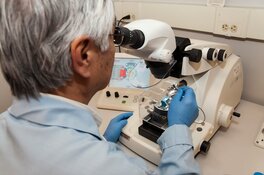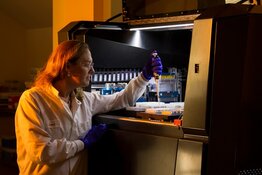The Life Sciences Report: You just returned from the 28th Annual European Conference on Treatment and Research in Multiple Sclerosis in Lyon, France. Putting aside the focus on multiple sclerosis, did you get any perspective on biotech markets in general?
Raghuram Selvaraju: Right now, everyone is talking about the major cost-containment pressures at work in the healthcare industry, and in Europe in particular, where a lot of economies are in deep financial trouble. Companies are concerned about the prospects of new drug launches. Once new drugs get through the approval process, they then have to go in front of reimbursement agencies in Europe. They are looking for advantageous pricing, but nowadays companies have to be prepared for a contentious battle, which was not historically the case. That has put a damper on enthusiasm within the context of the overall sector.
There are also concerns here in the U.S. about cost-containment pressures because we have a fiscal cliff looming. If Congress can't figure out how to put the country on a sustainable fiscal path, we will see draconian, automatically imposed cuts across the board within healthcare. These cutbacks will not only impact funding for research and clinical development, but will also affect the ability of the healthcare system to pay for drugs and other diagnostic and therapeutic interventions.
The overarching concern globally is cost containment. That is going to make things difficult for the biotech sector.
TLSR: Ram, there's been a change in the regulatory environment in the U.S. Would you address that?
RS: The overall mood among healthcare-focused institutional investors, whether hedge funds, mutual funds or venture capital firms, is generally bullish, principally because of the recent demeanor of the U.S. Food and Drug Administration (FDA). The FDA has approved a large number of drugs that have either been on its docket for a while or that people were not expecting the agency to approve in such a timely manner. The overall positioning of the agency looks very different from the way it was in the 2005–2006 era, when we saw the Vioxx (rofecoxib) scandal and the subsequent approval and then withdrawal of Tysabri (natalizumab). Tysabri eventually returned to the market after patients and physicians alike argued on its behalf, which illustrates how conservative the agency had become. The FDA went from being a somewhat permissive agency to extremely risk-averse. The new FDA attitude has been the principal driver of bullishness in the biotech sector recently. These days, when a drug is supposed to be approved—when it has demonstrated strong safety and clinically meaningful efficacy in the disease area that it is designed to treat—it has typically been approved.
TLSR: Do you think this loosened FDA stance will continue?
RS: Yes—at least until there is another scandal. The new stance of the FDA has been driven by voices in the Obama administration and in Congress saying the agency has become too risk-averse. Complaints by industry and patient advocacy groups have not gone unnoticed. We need new drugs, especially for significant unmet medical needs.
TLSR: You follow some micro-cap companies and do serious diligence on them, which is rare. Are micro caps suitable for retail investors?
RS: I want to make it absolutely clear that I don't consider any investment in biotech to be 100% suitable for the small retail investor. The retail investor who chooses biotech should only invest highly discretionary funds in the space. The older person with only $50,000 in retirement savings shouldn't go anywhere near the biotech sector, regardless of market cap.
TLSR: Are there special risks associated with stocks in the micro-cap realm?
RS: We have been taught that drug development costs a lot of money, and that it takes several hundred million dollars—at least—to get a drug from concept through the clinic and into the market. The problem with this approach is that investors become inured to the fact that biotech companies are serially raising money, diluting shareholders and carrying an accumulated deficit of several hundred million dollars before getting a drug across the finish line and within sniffing distance of sustainable profitability. Personally, I think that is wrong and I have taken great pains to point out that all drug development does not have to be prohibitively expensive.
TLSR: Ram, is there a company that meets that criterion?
RS: IntelGenx Corp. (IGX:TSX.V) is a company in my coverage universe that has an accumulated deficit of only $17.5 million ($17.5M), a market cap of less than $36M and an enterprise value of about $30M. But the company has managed to get FDA approval for a drug without help from an external party, whether a partner or otherwise. The drug is Forfivo (bupropion), a higher-dose, extended-release version of Wellbutrin for major depressive disorder; it is being launched by IntelGenx's sales partner Edgemont Pharmaceuticals LLC.
"The overarching concern for biotech globally is cost containment."
IntelGenx has proven a drug can be taken through development and to the market successfully without spending a massive amount of money. This drug may represent only a niche opportunity, and I'm not suggesting that it is a blockbuster. But the company has succeeded where much larger companies have failed to get anything approved. There are many illustrations of the hypothesis that drug development can be done in a cost-effective, capital-efficient way. Telling investors that all drug development is expensive is disingenuous and wrong.
TLSR: Aside from capital efficiency, what else do you look for using this type of investment thesis?
RS: I look for management teams with substantial ownership stakes in their own companies. I don't like it when CEOs pay themselves massive salaries and don't own a single share of stock—that's a disaster waiting to happen. IntelGenx was founded by its president and CEO, Horst Zerbe, who still owns 23% of the company. He founded IntelGenx as a formulation expertise-focused company, and now it has three core platform technologies that enhance drug delivery, enable development of novel formulations and improve the dosing convenience of existing drugs. Notice I said existing drugs. This company is not engaged in pie-in-the-sky, de novo drug development on a novel, invalidated target. It is improving existing agents that have indisputable safety and efficacy profiles.
The company has a plethora of clinical-stage candidates, all of which are amenable to approval via the FDA's 505(b)(2) regulatory pathway, which is a hybrid of the abbreviated new drug application, used by generics companies, and the new drug application (NDA), used by branded pharmaceutical companies. The 505(b)(2) route has distinct advantages because companies get the same exclusivities given to de novo development via NDA, but have the added advantage of working in a domain wherein chances of approval are much higher.
In my opinion, IntelGenx's model represents not only a cost-effective approach to drug development but a risk-mitigated approach as well. Saying you are going to dilute him/her to the smallest extent possible is a responsible message to take to the shareholder. Horst Zerbe can say that because he is a shareholder in his own company.
TLSR: In addition to IntelGenx's Forfivo, the company has a pipeline of products for insomnia, migraine, erectile dysfunction and neuropathic pain management, among others. Is your $3 target price driven solely by Forfivo, or do you have these other products factored into your model?
RS: I attempt to ascribe a risk-mitigated net present value to all components of a company's clinical-stage pipeline. My valuation methodology takes account of IntelGenx's other drug candidates, but I ascribe a $1/share amount to the company's lead product candidate, Forfivo, by itself.
TLSR: Is there another example you would like to talk about?
RS: Following in the capital-efficiency vein, Israel-based BioLineRx Ltd. (BLRX:NASDAQ) (BLRX:NASDAQ) is an interesting company. It has a good pedigree; the company was co-founded by Teva Pharmaceutical Industries Ltd. (TEVA:NASDAQ) and has been an incubator project. BioLineRx has done some cost-effective, cost-contained, capital-efficient drug development. Since its inception roughly nine years ago, it has raised about $120M. It has burned through about $90M or so while building a pipeline of seven clinical-stage candidates and more than 20 preclinical candidates, all of which are optimized. The company trades at an enterprise value of less than $30M, but its pipeline is commensurate with that of a company 10 or 15 times its size.
TLSR: Are you applying the concept that some micro-cap stocks are not necessarily the great risk that consensus opinion seems to indicate with regard to BioLineRx?
RS: Yes. We see a massive amount of value in BioLineRx, available at a disproportionately low price. Not to mention that the company has two drug candidates in phase 3 development, with results from both pivotal programs due over the course of next year. The company does not lack near- and mid-term value-driving catalysts. It's quite the opposite.
"If Congress can't figure out how to put the country on a sustainable fiscal path, we will see draconian, automatically imposed cuts across the board within healthcare."
I am particularly impressed that BioLineRx has managed to develop multiple drug candidates in different disease indications simultaneously in an organized manner, without burning a lot of money in the process. A case in point: The company recently reported that it completed preclinical development for a hepatitis C (HCV) candidate. That alone should be sufficient motivation for investors to significantly bid up the price of the stock, because HCV is a hot disease indication right now. We have seen a rash of high-priced acquisitions, deals and partnerships in this domain, and I expect that to continue. With HCV, companies can start throwing off efficacy data almost as soon as they are in clinic or start dosing patients—data that the market can take to the bank.
TLSR: Shares of BioLineRx are up 39% in the past four weeks, yet it only has a $57M market cap.
RS: Exactly. By the end of Q3/12, it is probably looking at $25–26M in cash. We are talking about an under-$30M enterprise value, which seems paltry in light of what is going on at this company.
TLSR: Can you mention another company that you like?
RS: Ampio Pharmaceuticals Inc (AMPE:NASDAQ) is also focused on the 505(b)(2) pathway. The company is interesting principally because it looks at repurposing approved drugs for new disease indications. This is a more sophisticated model than IntelGenx's, which is focused on reformulation but not changing the purpose of the drug. And as I said before, the 505(b)(2) application advantage is that the route to market is significantly abbreviated, and the cost associated with clinical development is significantly lower.
TLSR: Could you address Neuralstem Inc. (CUR:NYSE.MKT)? You follow the company and Aegis Capital recently participated in two equity financings, in which nearly $10M was raised.
RS: Sure. I visited Neuralstem's histology lab in San Diego in August 2010. I saw some very interesting animal data, which intrigued me because I did stem cell experiments in models of neurodegenerative disease when I worked in industry. It was devilishly difficult to get any kind of meaningful result out of the model systems. The stem cells that we injected went everywhere except where they were supposed to. They did not provide any kind of regenerative effect at all. We basically gave it up as a lost cause.
Yet this little company, Neuralstem, was demonstrating that implantation of its neural stem cells into a rat's spinal cord could generate axonal tracts—nerve fibers—along the entire length of the spinal cord, from head to tail. Before implantation, the spinal cords of these animals had been completely severed through a crush operation. When the company showed me these results, I was extremely impressed.
I thought this result deserved publication in a high-impact scientific journal. Lo and behold, just about a month ago, the research and results appeared in Cell, the journal with the highest impact factor in the life sciences space bar none. A Cell paper can represent 10 years of work.
The science underlying Neuralstem, in my opinion, is truly world class. Even though the company, in my view, is very risky and speculative, and is five to seven years away from entering the market with a therapy, I believe it is a worthwhile investment opportunity for the risk-tolerant biotech investor. The science is of high quality.
TLSR: The preclinical research makes me wonder why companies are not doing clinical trials in acute stroke or acute spinal injury. Why are we waiting, in human trials, until scar tissue forms and we lose regenerative power before we try stem cell implants? Is Neuralstem looking at acute indications that would correspond to the rodent studies?
RS: Neuralstem has tried to target the most difficult problems around. It has done neural stem cell-based clinical trials in diseases like amyotrophic lateral sclerosis (ALS), chronic ischemic stroke and so on. Its rationale is that these are the most significant unmet medical needs; these patients are beyond help. If the company can demonstrate any improvement at all, it will have a clear path to market, and can charge very high prices for its medications. The downside, of course, is that the hurdle is very high, and there is a high probability of failure. Another problem with doing acute studies, as in the acute stroke setting, is the ticking clock. You want to get therapy to the stroke patient within eight hours.
TLSR: Many acute stroke patients recover on their own. But what about severance of the spinal cord? Can you address that from an acute-injury perspective?
RS: Neuralstem could very easily focus on the treatment of acute spinal cord injury. But another company that I cover, InVivo Therapeutics Holdings Corp. (NVIV:OTCBB), is focusing on that space. InVivo's modus operandi is to inject a scaffold of an inert biomaterial into the spinal cord, essentially preventing damage from spreading and preventing the formation of scar tissue. Because scar tissue doesn't form, a more permissive environment for regeneration is created, driven by endogenous factors inside the spinal cord itself. InVivo is geared more toward the acute therapy setting with regard to spinal cord injury than Neuralstem is.
TLSR: I understand what you are saying about difficult indications. If a therapy shows any efficacy in a truly unmet need, is the FDA likely to approve it?
RS: Yes. And Neuralstem believes that because its stem cells have been engineered to regenerate the pieces of the neuronal circuitry that are deficient in these neurodegenerative disorders, it can go after chronic spinal cord injury and still hope to have success.
The company has a potential ace up its sleeve. Its small molecule program focuses on disease indications that are less chronic in nature and in which activity could be observed in a much shorter period of time. Its lead small molecule candidate, NSI-189, is being developed for treatment of major depressive disorder. We could see efficacy data early next year. In the future, we could see the molecule being applied to enhancement of cognitive function in healthy people.
TLSR: Are there synergies between the small molecule development program and the stem cell platform?
RS: There are. The small molecules would not have been discovered without the company's expertise in the neural stem cell domain. It uses its neural stem cells as a screening platform from which to identify proprietary small molecules with neurological implications.
TLSR: The company is interrogating the stem cells with the small molecules?
RS: Yes. That is how Neuralstem's discovery effort on the small molecule side works. The company envisions utilizing the small molecule and the neural stem cell solution in the same patient, at the same time, to create a synergistic interaction between the two. It hopes to stimulate endogenous regeneration—neuronal sprouting—in areas like the hippocampus (the area of the brain that governs learning and memory) by applying the small molecule systemically and, at the same time, injecting a neural stem cell into the brain. This could selectively give rise to dopaminergic neurons, which are deficient in people with Parkinson's disease. Both therapeutic agents could be applied together to the same patient.
TLSR: Are Neuralstem's cell lines genetically modified or hormonally enhanced?
RS: No. Based on the area of the brain they came from, they preferentially differentiate into the various kinds of neurons. The company has one stem cell line that preferentially gives rise to dopaminergic neurons. It has another stem cell line that preferentially gives rise to cholinergic neurons, which would be used in Alzheimer's disease. And it has one cell line being used in an ALS study (and that was the focus of the Cell paper), which gives rise to GABAergic neurons (secreting γ-aminobutyric acid), which would have a role in mediating recovery from spinal cord injury and could have a role in reconstituting motor neuron circuitry (deficient in ALS).
TLSR: You also follow Lpath Inc. (LPTN:NASDAQ), a company developing new monoclonal antibodies engaging new targets.
RS: Lpath recently instituted a 1-for-7 reverse stock split, which has taken the company to the NASDAQ from the Bulletin Board. This company has also undertaken a capital-efficient approach to drug development.
"The overall mood among healthcare-focused institutional investors is generally bullish, principally because of the recent demeanor of the FDA."
I like Lpath for three reasons. First, it is a monoclonal antibody company. When I initiated coverage on Lpath, a section in my report was entitled "Everyone Loves an Antibody Company," which is absolutely true. Monoclonal antibodies are high-value products. If you look over the course of the past 15 or so years, there have been more acquisition transactions involving monoclonal antibody platform companies than there have been of any other technology type or drug class in the entire biotech industry. The most recent example was the acquisition of Micromet Inc. by Amgen Inc. (AMGN:NASDAQ). Micromet didn't have any approved products, and it had one candidate on the cusp of entering phase 3, but Amgen paid $1.1 billion ($1.1B) for it.
Second, I like Lpath because its monoclonal antibody-focused platform technology is unique. It is the only company in the world that has figured out how to make monoclonal antibodies against a particular class of molecules—not proteins, as is the normal case, but molecules known as bioactive lipids, which are very important inflammatory mediators. They also regulate the fibrotic process. They are master regulators in many ways. These molecules have been very difficult to target. Most strategies targeting bioactive lipids involve interfering with the receptors of those lipids, but that is very inefficient because multiple receptors are targeted by the same bioactive lipid. I like Lpath because its technology platform is clearly differentiated and focuses on a class of molecules with massive potential in terms of specific targeting in disease conditions.
Lastly, I like Lpath because of its lead indication, which is wet age-related macular degeneration (AMD). The target is sphingosine 1 phosphate (S1P). I love ophthalmology as a disease indication because the eye is a surface organ, and it can be targeted with topical medications like eye drops, as well as with microimplants and intravitreal injections. As soon as systemic exposure is taken out of the equation, the risk profile of a drug drops by 20–30%, and the FDA loves that. There is no need to worry about cardiotoxicity or renal toxicity or liver toxicity, all of which are typical concerns with any standard pill. Ophthalmology is also a great indication because visual acuity is a simple endpoint to measure in a clinical study. It is evaluated with an eye chart. The third thing that makes ophthalmology an easy indication is that clinical trials can be done over short periods of time. A drug's efficacy can be measured within three or four weeks. If it's not doing anything by then, it's never going to do anything.
In the ophthalmology domain, we have seen a rash of acquisitions. ISTA Pharmaceuticals Inc. (ISTA:NASDAQ) was acquired by Bausch & Lomb Inc. (private) this past summer and Inspire Pharmaceuticals Inc. (ISPH:NASDAQ) by Merck & Co. Inc. (MRK:NYSE). The big kahuna, Novartis AG (NVS:NYSE), got Alcon Laboratories for $12.9B. Big pharma has a major jones for ophthalmology, and Pfizer Inc. (PFE:NYSE) is partnered with Lpath in its AMD program, which is now in phase 2 and will report results by the summer of 2013. If data are positive, it could pave the way for Lpath to be acquired by Pfizer. I don't see any reason why Pfizer would hold back at that point.
TLSR: It's amazing how many indications, including systemic disease, could be affected by targeting S1P.
RS: I agree. Sphingosine I phosphate is also a target in multiple sclerosis, and in cancer. Lpath has demonstrated the impact of targeting sphingosine I phosphate with its monoclonal antibody in cancer already. There is a lot of potential in Lpath's technology platform, which the market is discounting.
TLSR: Does Pfizer have any ownership in Lpath?
RS: Pfizer does not have any equity investment in Lpath.
TLSR: You do not follow VentriPoint Inc. (VPT:TSX.V), but can you talk about the company?
RS: We have been in touch with VentriPoint for a while now because we think its technology platform is very interesting. It has developed an intelligent way of imaging the heart, taking a page out of the playbook of Pixar Animation Studios, which has made films like Toy Story. Are you familiar with what Pixar does?
TLSR: The company animates a figure, and then its software fills the figure in.
RS: Exactly. The technology is called Piecewise Smooth Subdivision Surface (PSSS).
Pixar generates animations with smooth surfaces by approximating an area in which a smooth surface should appear (like a floor of a room) with a coarse mesh made up of many tiny polygonal elements. By using more and more polygons, the mesh gets smoother and smoother until eventually it creates the appearance of a smooth surface, to the point where the human eye cannot detect anything different.
"We have been taught that drug development costs a lot of money. Personally, I think telling investors that all drug development is expensive is disingenuous and wrong."
With PSSS, VentriPoint is enabling clinicians to use ultrasound scans, done with relatively inexpensive equipment and composed of a limited amount of information, to sketch accurate 3-D renditions of right ventricular malformations. This highly proprietary modeling approach is very powerful and can be applied to very serious conditions, like tetralogy of Fallot, which gives rise to what were called "blue babies." It detects other conditions as well, such as pulmonary arterial hypertension, which afflicts adults mostly and is life-threatening. There are multiple applications for this diagnostic methodology.
The great advantage of the system goes to cost containment. There are money savings because it allows clinicians to do the same kind of imaging with ultrasound that they would otherwise have to get with a CAT scan or MRI, which are erratic and difficult to use. Very expensive MRI or tomography machines are freed up for more lucrative things, such as, for example, brain imaging. My view is that this technology is fundamentally underrated and misunderstood by the market.
TLSR: To be clear, normal ultrasound imaging systems can use the software. Is that right?
RS: That is correct. Basically, this system is plug-and-play. Buy the software from VentriPoint, and you are pretty much ready to go.
TLSR: Ram, could this be a point-of-care service in smaller clinics, and perhaps in underserved developing world areas—places where you would never find MRI equipment?
RS: Yes. The advantage is that you can provide access to reliable cardiac imaging in places that previously would never have been able to accomplish that.
TLSR: Was there one more company you wanted to mention?
RS: The last company that I would highlight is Synergy Pharmaceuticals Inc. (SGYP:NASDAQ). The company is in a single phase 3 trial with a drug candidate very closely related to Ironwood Pharmaceuticals Inc.'s (IRWD:NASDAQ) recently approved drug, linaclotide, which is going to be launched in December under the trade name Linzess. Linzess went through four phase 3 trials in chronic constipation and irritable bowel syndrome, and met 66 primary and secondary endpoints with statistical significance.
Linzess is based on an endogenous human hormone, but it is not an exact replica of that hormone. Instead, it is a peptide that was identified in a bacterial endotoxin that is known to perform some of the same functions as the endogenous human hormone, which stimulates fluid secretion into the intestine. Obviously, if there is more fluid in the intestine, there is greater gastric motility, and therefore issues associated with chronic constipation and irritable bowel syndrome can potentially be resolved. Synergy has a direct copy of the endogenous human hormone, plecanatide (formerly SP-304). If the mechanism has been validated by Ironwood's drug, and Ironwood's drug causes some diarrhea as a side effect because the bacterial endotoxin overstimulates the receptor and oversecretes fluid into the intestine, Synergy's drug candidate is not only more risk-mitigated but also could demonstrate comparable efficacy without the problem of diarrhea.
TLSR: How much could Synergy Pharmaceuticals be worth?
RS: Ironwood is worth roughly $1.4B, but it only owns about 40% of Linzess, whereas Synergy owns 100% of plecanatide. Using Ironwood's current market cap of about $3B as a proxy, we think Synergy's $300M market valuation represents an unwarranted discrepancy.
TLSR: Ram, I've enjoyed this. Thank you.
RS: I've enjoyed it very much.
Raghuram "Ram" Selvaraju's professional career started at the Geneva-based biotech firm Serono in 2000, where he discovered the first novel protein candidate developed entirely within the company. He subsequently became the youngest recipient of the company's Inventorship Award for Exceptional Innovation and Creativity. Selvaraju started in the securities industry with Rodman & Renshaw as a biotechnology equity research analyst. He was the top-ranked biotech analyst in the Wall Street Journal's "Best on the Street" survey (2006) and went on to become head of healthcare equity research at Hapoalim Securities, the New York-based broker/dealer subsidiary of Bank Hapoalim B. M., Israel's largest financial services group. While at Hapoalim, Selvaraju was regularly featured in the Wall Street Journal, Barron's, BioWorld Today, and Reuters/AP. He was also a regular guest on the Bloomberg TV program "Taking Stock," appeared with Bloomberg TV's on-air correspondents Betty Liu and Gigi Stone and was a guest on CNBC's "Street Signs with Herb Greenberg."
Want to read more exclusive Life Sciences Report interviews like this? Sign up for our free e-newsletter, and you'll learn when new articles have been published. To see a list of recent interviews with industry analysts and commentators, visit our Exclusive Interviews page.
DISCLOSURE:
1) George S. Mack of The Life Sciences Report conducted this interview. He personally and/or his family own shares of the following companies mentioned in this interview: None.
2) The following companies mentioned in the interview are sponsors of The Life Sciences Report: Neuralstem Inc., Lpath Inc., VentriPoint Diagnostics Ltd. Merck & Co. Inc. is not affiliated with Streetwise Reports. Streetwise Reports does not accept stock in exchange for services. Interviews are edited for clarity.
3) Ram Selvaraju: I personally and/or members of my immediate household own shares of the following companies mentioned in this interview: None. I personally and/or members of my immediate household am paid by the following companies mentioned in this interview: None. I was not paid by Streetwise Reports for participating in this interview.
4) Aegis Capital Corp. has received compensation for investment banking services from the following firms within the past 12 months: Ampio Pharmaceuticals, Neuralstem Inc., Synergy Pharmaceuticals. Aegis may seek to obtain compensation for investment banking services from any or all of the companies mentioned over the course of the next three months. The firm does not own 1% or more of the outstanding shares of any of the companies mentioned.









































